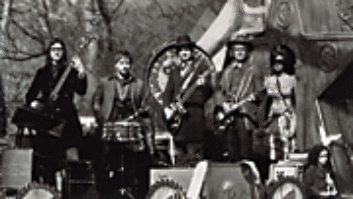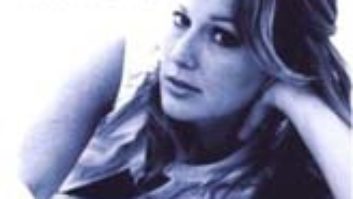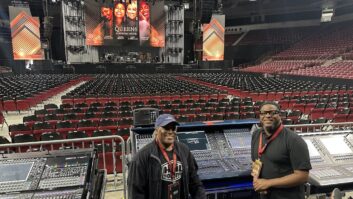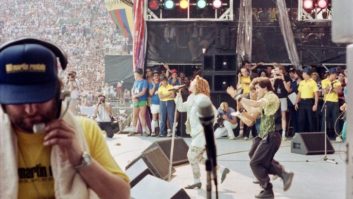As the baby boomer generation ages, the ranks of rock ‘n’ roll continue to swell with rock elder statesmen, not yet ready to fade away. The emphasis in elder statesmen, however, remains on the word “men.” Few women seem to inspire the same devoted following as, say, a Beatle or Bob Dylan…except for Patti Smith.
At 53, the mother of all punk put out one of her most critically acclaimed CDs in years, Gung Ho, her eighth album and the recording that fulfills the contract she signed with Arista 25 years ago. Only one of those albums, Easter, produced a Top 40 hit: “Because the Night,” co-written by Smith and Bruce Springsteen, which crested at 13 in 1978. But her influence extends beyond the singles sold and into the recordings of R.E.M., Jim Carroll, Exene Cervenka, the Pretenders and other women rock ‘n’ rollers who look as cool as a Stone and retain their own voice.
But although Smith’s inspiration has been felt, her appearances have been few and far between since 1977, when she broke her neck after twirling off a stage in Florida during “Ain’t It Strange.” After “Because the Night,” she married Fred “Sonic” Smith of the MC5 in 1980, and apart from a few mainly spoken-word performances, she didn’t perform with a band until 1995, after her husband’s death.
Since then, Smith’s shows have acquired a legendary mystique, and this album tour probably marks one of her longest stretch of appearances of late. In March, she kicked off the release of the new record with a South by Southwest concert, appearances on Late Show With David Letterman and The Tonight Show and a taped performance of “Because the Night,” with Sarah McLachlan accompanying her on keyboards, which was scheduled to be televised as part of the Arista Records 25th Anniversary Special. In April, the poet-turned-rock ‘n’ roller did a two-week West Coast club tour with two original Patti Smith Group members, guitarist Lenny Kaye and drummer Jay Dee Daugherty, as well as guitarist and significant other Oliver Ray and bassist Tony Shanahan.
Smith’s challenge is now one that many working moms face; she’s torn between work and family, speculates freelance FOH engineer Martin le Maire of Rehoboth Beach, Del. “[Smith] hasn’t been working so consistently that we have a real rhythm down,” he explains. “She goes out, comes back home, and goes out. She’s got two kids that she has to give attention to, so she’s got a real life at home. This summer, though, once her daughter is out of school, I’ll imagine we’ll be touring a lot more.”
It makes sense that Smith has gathered a crew around her that she considers a second family. “She’s really great to work with and very, very forgiving,” le Maire says. “It’s not like, ‘Oh, you gotta do this or you’re fired.’ It’s not like the band and the crew-it’s very much like a family sort of thing. I think she likes having people that she knows well and likes.”
A friend of Shanahan since their days in Philly/Jersey bands, le Maire started doing occasional shows with Smith three years ago, and when her permanent engineer Pablo Wheeler left to go work with Bob Dylan, he stayed on, beginning with a European tour last summer. “Patti is the first act that I’ve worked with of that major status, rock icon status. It’s been really exciting,” drawls the laid-back engineer, hanging out before the second of three Fillmore shows, in the venue’s poster-lined lounge. “People think she’s this rough, spit-on-your-shoe kind of person. But she’s really very sweet.”
This leg of the tour isn’t carrying a P.A. or console because of the size of the venues, which include Wilshire Theatre in L.A. and the Commodore at Vancouver. So, in keeping with the revolutionary spirit, le Maire says he gets Smith’s message across “by whatever means are necessary,” with help from Smith’s long-time guitar tech Yeuk Wong, tech Andrew Burns and tour manager and tech Barre Duryea. (There’s no monitor engineer.) It’s “equipment du jour,” although if he had his druthers, le Maire would prefer EAW systems and Yamaha PM4000s, because he likes to put the whole band on one VCA and her vocal on another and work the two against each other during the rockin’ songs. At the Fillmore, it’s a Crest desk with a Meyer P.A.
Every show demands a very active mix, le Maire says. Smith keeps le Maire on his toes, with both hands on the console, as she spontaneously adds songs to her set, mixes the tunes up, or launches into a monologue about Palm Sunday, as she did at that night’s concert. “She’s just really dynamic. She’ll be singing and then just pull this clarinet out and wail on it,” he explains. “So you have to be prepared. It’s not a static set to mix and forget about. There’s a lot of manual attention needed. I don’t sit there with a one-finger kind of thing.”
The show at the Fillmore that night ranged from the infamous “Ain’t It Strange” and “Gloria” to Gung Ho’s “One Voice” and “Stranger Messengers,” sweeping from a whisper to a scream or “full-out band chaos,” as le Maire puts it, in one song. “She’ll be all over the stage, kneeling down, sometimes laying on the floor. She’ll get out in the audience with the microphones. You really got to pay attention with her because it’ll be a surprise sometimes,” he recalls. “The dynamics are pretty wide, pretty up and down, so there’s lots of compression used on things just to keep things in check.”
Three Distressors, manufactured by his old friend Dave Durr at Empirical Labs, keep the vocal, bass guitar and drums in line. “They just give you a lot of really good control,” le Maire says. “You don’t really hear any ill effects from it. They’re just very fast, and they work very well. I know they’re meant mostly for the studio, but I think they’re out on the road fair amounts.” He also patches a dbx 1066 across the stereo toms subgroup.
At the Fillmore show, the engineer used Shure mics all around, with Beta 58As on Smith’s vocals. “I know there are other, more high-fidelity microphones,” he says. “But for her, especially, when she’s onstage, sometimes she knocks the mic over, and it hits the floor, because she just gets excited up there, and it gets a little rambunctious. The Beta 58As seem to take whatever happens up there.”
Le Maire also tries to match his mix with Smith’s vibe. “The guitars really need to be up there and in your face with her vocal sitting in there,” he says. “She’s not necessarily on the microphone all the time, so I really have to keep that in mind because she’ll move off it a lot. She just really gets into her songs, and she’s not paying attention to certain things like that too much. It’s more the effect of the show, just her energy and the message she has.”
The new album does sound more polished than previous recordings, such as Radio Ethiopia, so le Maire says he “spec’d out a Harmonizer for this leg, because a lot of the songs and mainly the single [‘Glitter in Their Eyes’] have a lot of triple-tracked vocals or something. So I’m trying to simulate that to get a thicker vocal sound.”
Most of the time, her vocals just need a little reverb and occasionally a little delay, “but not all the time, and it’s not really exaggerated,” le Maire says. “It’s not a real polished, produced kind of sound. We try to keep it kind of raw so there’s a little bit of room sound on the kit. Depends on the song, some songs are much more bigger and open, and there’s space to let the reverb hang a little bit. I’d say ‘Southern Cross’ is one that has a much larger sound, has much more open space for bigger reverbs and stuff like that. There’s other songs that are just very small, like ‘Grateful.’ It’s basically her on her own acoustic guitar, and it’s a very intimate little song that she dedicated to Jerry Garcia. It’s almost like a little country type of tune.”
Le Maire uses whatever mics the club has, such as Sennheiser 409s or Shure SM57s, on the guitars, because “basically it’s a straight-ahead kind of rock ‘n’ roll show.” To keep the stand clutter down, Shure SM98s are clipped on the four toms and snare, and the engineer carries his own AKG 451s for the hi-hat and ride, Audio-Technica 4041s for the overheads, and an Electro-Voice 868 for the kick. “I can work with anything, pretty much, but I’m particular about having decent mics for cymbals,” he adds. “If a club has a Beyer 88, that’s a preference, but ever since I blew a diaphragm on the one I have, I don’t bring it out anymore. They’re not meant for kick drum really, but everyone loves the way they sound on a bass drum. They’re more a vocal mic. I found that out by blasting one of mine and having it fixed, and it cost more than the microphone.”
Le Maire believes the tour might add a monitor engineer when it was scheduled to continue in May and cover the rest of the U.S. But for now, Smith is just experimenting with Shure in-ears during rehearsal. “She’s interested, but it can really throw her off because with both of them she’s totally isolated and you really need a monitor engineer to give her everything she needs. We’re thinking of trying just one with her, with just her main and vocal in it,” he says. “I think she’s happy right now just dealing with wedges, what she’s used to. That’s all she’s ever had since the ’70s.”
Still, le Maire has his work cut out for him, as he seamlessly blends songs from the ’70s and ’90s together while Smith plays shaman, summoning the spirit of rock ‘n’ roll ecstasy for audiences every night. “If people leave saying, ‘Wow, that was a great show. It sounded really good,’ I feel like I’m doing my job,” says le Maire, “because I’m super-picky. I’m never totally satisfied.”







